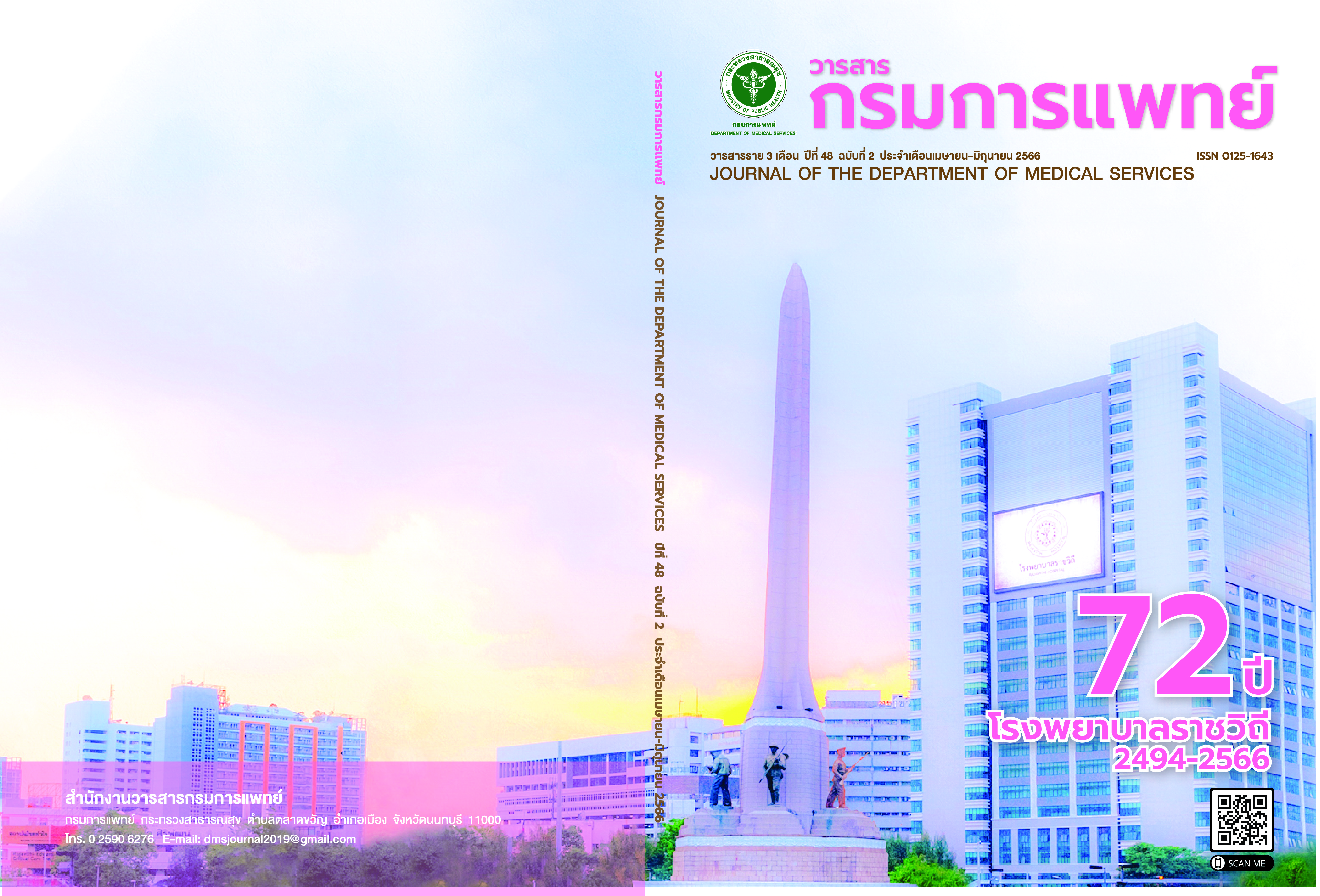การประเมินปริมาณรังสีจากการตรวจด้วยเอกซเรย์คอมพิวเตอร์และการรักษาด้วยการใส่สายสวนหลอดเลือดสมองของผู้ป่วยโรคหลอดเลือดสมองตีบหรืออุดตันเฉียบพลัน
DOI:
https://doi.org/10.14456/jdms.2023.30คำสำคัญ:
โรคหลอดเลือดสมองตีบหรืออุดตันเฉียบพลัน, ปริมาณรังสียังผล, การรักษาด้วยวิธีการใส่สายสวนหลอดเลือดสมอง, มะเร็งบทคัดย่อ
ภูมิหลัง: การรักษาโรคหลอดเลือดสมองตีบหรืออุดตันเฉียบพลันมีหลายวิธี หนึ่งในวิธีการรักษาที่ใช้มากในสถาบันประสาทวิทยาคือการรักษาด้วยการใส่สายสวนหลอดเลือดสมองโดยใช้เครื่องเอกซเรย์หลอดเลือด ผู้ป่วยกลุ่มนี้จึงได้รับรังสีจากการตรวจเอกซเรย์คอมพิวเตอร์และเอกซเรย์หลอดเลือด วัตถุประสงค์: เพื่อหาค่าปริมาณรังสีของผู้ป่วยโรคหลอดเลือดสมองตีบหรืออุดตันเฉียบพลันที่ได้รับจากการตรวจเอกซเรย์คอมพิวเตอร์ร่วมกับการรักษาด้วยการใส่สายสวนหลอดเลือดสมองด้วยเครื่องเอกซเรย์หลอดเลือดและทำการประเมินความเสี่ยงจากรังสีต่อผู้ป่วย วิธีการ: คำนวณหาปริมาณรังสียังผลโดยใช้ค่าแก้ ของผู้ป่วยโรคหลอดเลือดสมองตีบหรืออุดตันเฉียบพลันที่ได้รับการรักษาด้วยวิธีการใส่สายสวนหลอดเลือดสมองจำนวน 61 คน ระหว่างวันที่ 1 ตุลาคม 2562 ถึง1 ตุลาคม 2563 ด้วยการเก็บข้อมูลย้อนหลังจากเครื่องเอกซเรย์คอมพิวเตอร์และเครื่องเอกซเรย์หลอดเลือด ผล: ผู้ป่วยที่ได้รับการวินิจฉัยว่าเป็นโรคหลอดเลือดสมองตีบหรืออุดตันเฉียบพลันที่ได้รับการรักษาด้วยวิธีการใส่สายสวนหลอดเลือดสมองเป็นเพศหญิง 28 คน (ร้อยละ 45.9) และเพศชาย 33 คน (ร้อยละ 54.1) มีอายุระหว่าง 40 - 89 ปี อายุเฉลี่ย 64 ปี การตรวจเอกซเรย์คอมพิวเตอร์มีค่าดัชนีปริมาณรังสีเอกซเรย์คอมพิวเตอร์เชิงปริมาตรมีค่าเฉลี่ย 40.71±13.88 มิลลิเกรย์ ผลคูณปริมาณรังสีกับความยาวมีค่าเฉลี่ย 1938±638 มิลลิเกรย์เซนติเมตร การรักษาด้วยวิธีการใส่สายสวนหลอดเลือดสมองมีปริมาณรังสีที่ผิวมีค่าเฉลี่ย 242±229 มิลลิเกรย์ปริมาณรังสีคูณพื้นที่มีค่าเฉลี่ย 6192.3±4322.3 ไมโครเกรย์ตารางเซนติเมตร เวลาของการทำฟลูออโรสโคปีมีค่าเฉลี่ย 22±16 นาทีปริมาณรังยังผลจากเอกซเรย์คอมพิวเตอร์มีค่าเฉลี่ย 4.45±1.92มิลลิซีเวิร์ต (1.65-10.67 มิลลิซีเวิร์ต) ปริมาณรังยังผลจากการรักษาด้วยวิธีการใส่สายสวนหลอดเลือดสมองมีค่าเฉลี่ย 2.48±1.73 มิลลิซีเวิร์ต (0.40 - 8.63 มิลลิซีเวิร์ต) ปริมาณรังสียังผลรวมทั้งหมดที่ผู้ป่วยได้รับมีค่าเฉลี่ย 6.94±2.69 มิลลิซีเวิร์ต (2.63 - 13.73 มิลลิซีเวิร์ต) สรุป: ผู้ป่วยโรคหลอดเลือดสมองตีบหรืออุดตันเฉียบพลันที่ได้รับรังสีจากการตรวจเอกซเรย์คอมพิวเตอร์และการรักษาด้วยวิธีการใส่สายสวนหลอดเลือดสมองจะเพิ่มความเสี่ยงที่จะเสียชีวิตจากมะเร็งอยู่ในระดับต่ำมาก มีโอกาสเกิดขึ้น 1 ใน 10,000 เมื่อเทียบจากค่าเฉลี่ยปริมาณรังสียังผลที่ 6.94 มิลลิซีเวิร์ต และความเสี่ยงอยู่ในระดับต่ำ มีโอกาสเกิดขึ้น 1 ใน 1,000 เมื่อเทียบจากค่าสูงสุดของปริมาณรังสียังผลที่ 13.73 มิลลิซีเวิร์ต
เอกสารอ้างอิง
Donnan GA, Fisher M, Macleod M, Davis SM. Stroke. Lancet 2008;371(9624):1612-23.
Worakijthamrongchai T. Endovascular Treatment in AcuteIschemic Stroke. J Thai Stroke Soc 2017; 16(3):5-13.
Mccollough C, Cody D, Edyvean S, Geise R, Gould B, Keat N,et al. The Measurement, Reporting, and Management ofRadiation Dose in CT. American Association of Physicists inMedicine 2008; 96:11-3.
Shrimpton PC, Jansen JTM, Harrison JD. Updated estimatesof typical effective doses for common CT examinations inthe UK following the 2011 national review. Br J Radiol 2016;89(1057):20150346.
Hart D, Jones DG, Wall BF. Estimation of effective dose indiagnostic radiology from entrance dose and dose-areaproduct measurement (NRPBR262). Chilton, England: NationalRadiological Protection Board; 1994.
Mahesh M. Fluoroscopy: patient radiation exposureissues. Radiographics 2001; 21(4):1033-45.
Abul-Kasim K, Gunnarsson M, Maly P, Ohlin A, Sundgren P.Radiation Dose Optimization in CT Planning of CorrectiveScoliosis Surgery. A Phantom Study. Neuroradiol J 2008;21(3):374-82.
Jessen KA, Bongartz G, Geleijns J, Golding SJ, Panzer W,Jurik AG, et al. European guidelines on quality criteria forcomputed tomography, 16262EN. European Community; 2000.
Shrimpton PC, Hillier MC, Lewis MA, Dunn M. National survey ofdoses from CT in the UK: 2003. Br J Radiol 2006; 79(948):968-80.
Treier R, Aroua A, Verdun FR, Samara E, Stuessi A, Trueb PR.Patient doses in CT examinations in Switzerland: implementationof national diagnostic reference levels. Radiat Prot Dosimetry2010; 142(2-4):244-54.
Foley SJ, McEntee MF, Rainford LA. Establishment of CT diagnosticreference levels in Ireland. Br J Radiol 2012; 85(1018):1390-7.
van der Molen AJ, Schilham A, Stoop P, Prokop M, Geleijns J.A national survey on radiation dose in CT in The Netherlands.Insights Imaging 2013;4(3):383-90.
Wongsanon W, Phaorod J, Hanpanich P, Awikunprasert P. Studysurvey of Dose-Length Product from Computed TomographyExamination in Srinagarind Hospital, Khon Kaen University.SRIMEDJ 2020; 35(4):433-7.
Japan Association on Radiological Protection in Medicine, JapanAssociation of Radiological Technologists, Japan Network forResearch and Information on Medical Exposure (J-RIME), JapanRadiological Society, Japan Society of Medical Physics, JapaneseRadiation Research Society, et al. Diagnostic reference levelsbased on latest surveys in Japan—Japan DRLs 2015—. [internet]2016. [Cited 12 Oct 2020] Available from URL:https://www.radher.jp/J-RIME/report/DRLhoukokusyoEng.pdf.
Donmoon T, Chusin T. Establishment of local diagnosticreference levels for commonly performed computedtomography examinations in Thai cancer hospitals. Thai J RadTech 2021; 46(1):35-2.
Hassan AE, Amelot S. Radiation Exposure duringNeurointerventional Procedures in Modern Biplane AngiographicSystems: A Single-Site Experience. Interv Neurol 2017; 6(3-4):105-16.
Farah J, Rouchaud A, Henry T, Regen C, Mihalea C, Moret J,et al. Dose reference levels and clinical determinants in strokeneuroradiology interventions. Eur Radiol 2019; 29(2):645-53.
Friedrich B, Maegerlein C, Lobsien D, Mönch S, Berndt M,Hedderich D, et al. Endovascular Stroke Treatment on SinglePlane vs. Bi-Plane Angiography Suites : Technical Considerationsand Evaluation of Treatment Success. Clin Neuroradiol 2019;29(2):303-9.
Bärenfänger F, Block A, Rohde S. Investigation of RadiationExposure of Patients with Acute Ischemic Stroke duringMechanical Thrombectomy. Rofo 2019; 191(12):1099-106.
Weyland CS, Seker F, Potreck A, Hametner C, Ringleb PA,Möhlenbruch MA, et al. Radiation exposure per thrombectomyattempt in modern endovascular stroke treatment in the anteriorcirculation. Eur Radiol 2020;30:5039-47.
Verdun FR, Bochud F, Gundinchet F, Aroua A, Schnyder P,Meuli R. Quality initiatives* radiation risk: what you shouldknow to tell your patient. Radiographics 2008; 28(9):1807-16.
US National Academy of Sciences, National Research Council,Committee to Assess Health Risks from Exposure to Low Levelsof Ionizing Radiation. Health Risks from Exposure to Low Levelsof Ionizing Radiation. BEIR VII Phase 2. Washington, DC: NationalAcademies Press; 2006.
Martin CJ. Effective dose: how should it be applied to medicalexposures? Br J Radiol 2007; 80(956):639–47.
ดาวน์โหลด
เผยแพร่แล้ว
รูปแบบการอ้างอิง
ฉบับ
ประเภทบทความ
สัญญาอนุญาต
ลิขสิทธิ์ (c) 2023 กรมการแพทย์ กระทรวงสาธารณสุข

อนุญาตภายใต้เงื่อนไข Creative Commons Attribution-NonCommercial-NoDerivatives 4.0 International License.
บทความที่ได้รับการตีพิมพ์เป็นลิขสิทธิ์ของกรมการแพทย์ กระทรวงสาธารณสุข
ข้อความและข้อคิดเห็นต่างๆ เป็นของผู้เขียนบทความ ไม่ใช่ความเห็นของกองบรรณาธิการหรือของวารสารกรมการแพทย์



